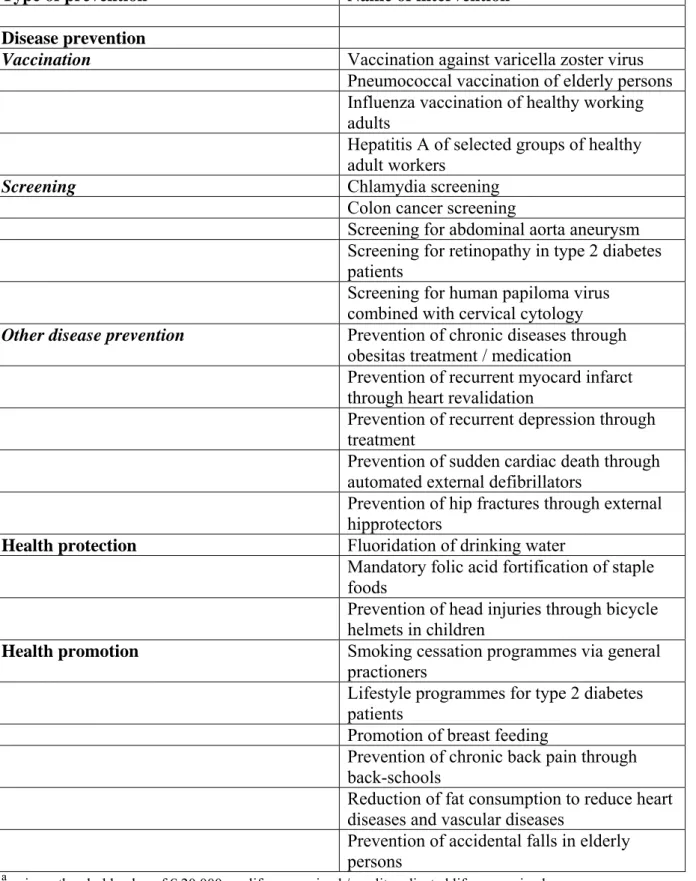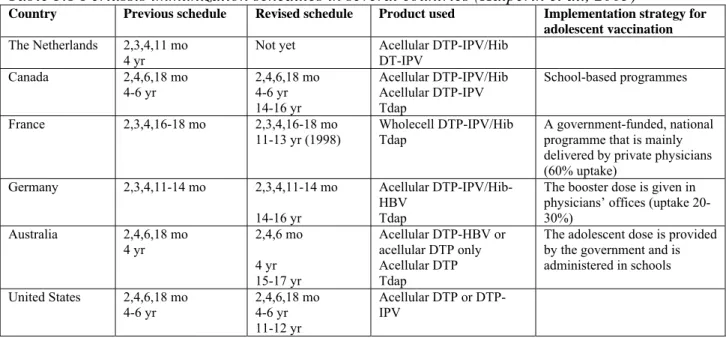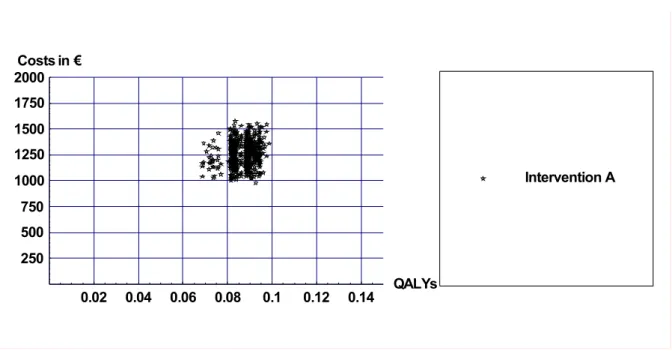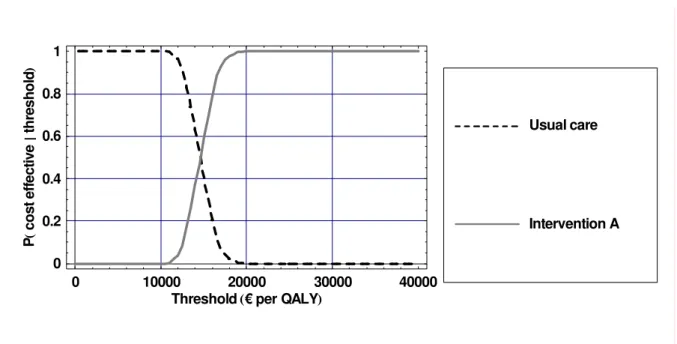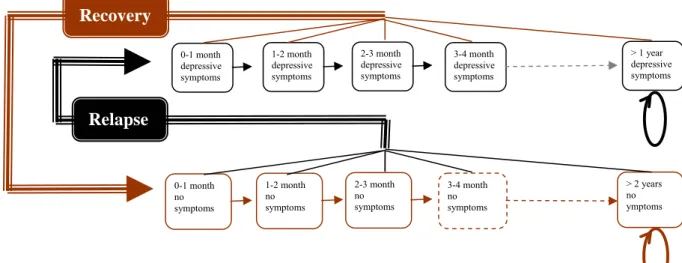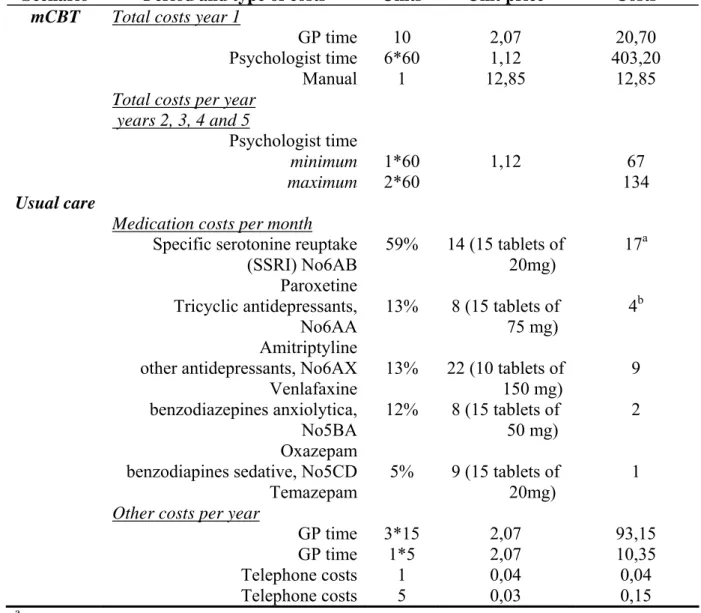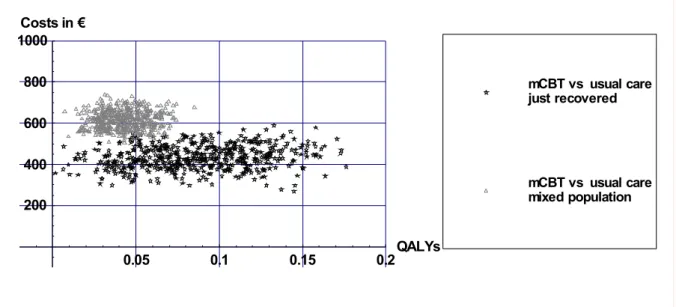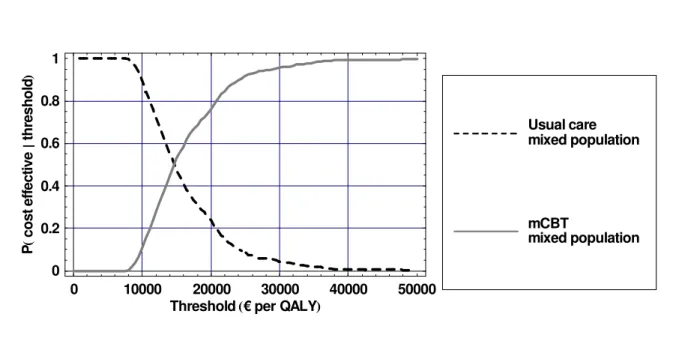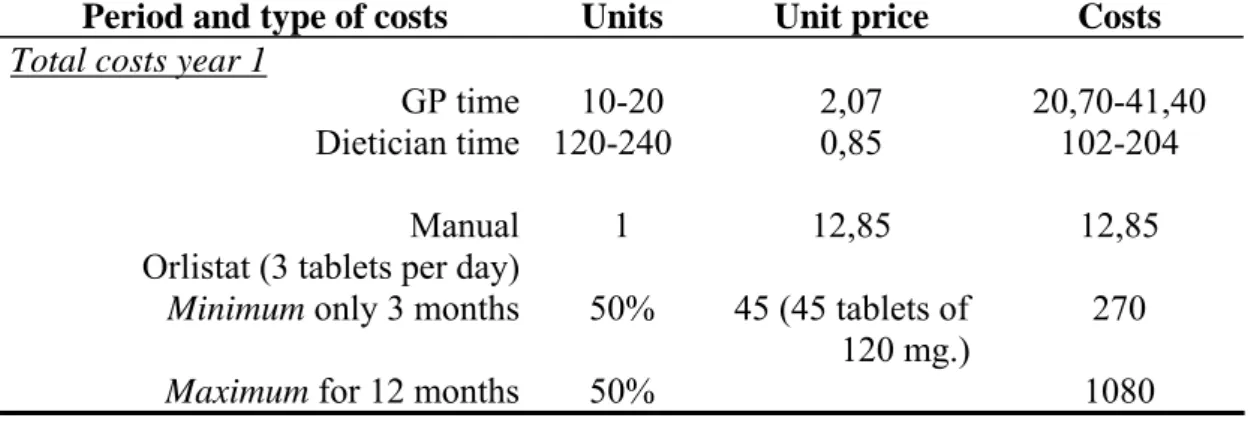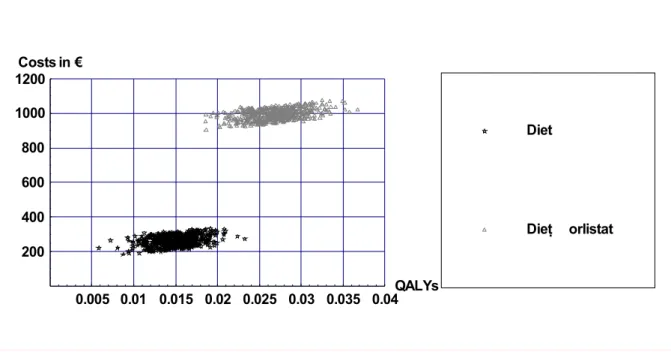Contact: GA de Wit
Centrum voor Preventie- en Zorgonderzoek
Ardine.de.Wit@rivm.nl
AJ Schuit
Centrum voor Volksgezondheid Toekomstverkenningen Jantine.Schuit@rivm.nl
RIVM report 270091004/2007
Economic evaluation of prevention: further evidence
GA de Wit, A Verweij, PHM van Baal, SMC Vijgen, M van den Berg, MCM Busch, MJM Barnhoorn, AJ Schuit
This investigation was performed by order and for the account of the Ministry of
Health, Welfare and Sports within the framework of project V/270901, Cost-effectiveness of prevention.
Abstract
Economic evaluation of prevention: further evidence
This report is the third in a series of reports that aim to identify cost-effective preventive interventions that have not yet been diffused into the Dutch health care system or into a public health setting.
In the first part of this report, five new interventions are presented and at the same time, renew the information on cost-effectiveness and implementation issues for six interventions that were described in less detail in our first report. For all eleven interventions, brief information on the magnitude and character of the health problem is presented, along with information on the intervention, its cost-effectiveness, and issues related to the transferability of foreign study results to the Dutch situation and possible future implementation of the intervention in the Netherlands. There is strong evidence for cost-effectiveness for (1)
screening for neonatal group beta streptococcal infections, (2) fluoridation of drinking water, (3) mandatory folic acid fortification of staple foods, (4) vaccination against varicella zoster virus and (5) stop smoking interventions. Evidence on cost-effectiveness is moderate for (6) influenza vaccination of healthy working adults, (7) rotavirus vaccination of newborns, (8) universal hepatitis B vaccination, (9) pertussis vaccination of adolescents, (10) human papilomavirus vaccination of adolescents, and (11) pneumococcal vaccination of elderly persons. However, for all interventions, we conclude that the transferability of the results to the Dutch situation is poor and more research is needed to investigate cost-effectiveness in the Dutch context. With respect to implementation opportunities, it is anticipated that screening for neonatal group beta streptococcal infections, pertussis vaccination of
adolescents, influenza vaccination of healthy working adults and pneumococcal vaccination of elderly persons is feasible.
In the second part of this report, the cost-effectiveness was modelled for two interventions that were shown to be cost-effective in an international context and had no major barriers for implementation in the Netherlands. The two interventions were the prevention of recurrent depression by maintenance cognitive behavioural therapy (mCBT), and the prevention of chronic diseases by pharmacologic treatment of obesity. The analyses showed that mCBT is more cost-effective than usual care, which is prescription of anti-depressive medication. Compared to usual care, mCBT has a cost-effectiveness ratio of € 15,000 per QALY. The cost-effectiveness of providing pharmacologic treatment (Orlistat) in combination with a diet is relatively high. Costs per QALY gained are € 62,000 for Orlistat plus diet compared to diet alone. The modelling study underlines the importance of performing Dutch specific cost-effectiveness analyses and confirms the low transferability of foreign studies to the Dutch situation as was shown in the first part of the report.
Key words: cost-effectiveness analysis, economic evaluation, modelling, prevention, health protection, health promotion, vaccination, screening,
Rapport in het kort
Economische evaluatie van preventie: nadere bewijslast
Dit rapport is de derde in een serie van rapporten over de doelmatigheid van preventieve interventies die nog niet systematisch in Nederland in de (openbare) gezondheidzorg zijn ingevoerd.
In het eerste deel van dit rapport worden vijf nieuwe preventieve interventies gepresenteerd en wordt tevens de kennis ten aanzien van zes eerder beschreven interventies up-to-date gemaakt. Per interventie wordt achtereenvolgens het gezondheidsprobleem waar de
interventie op gericht is, de interventie zelf, de doelmatigheid (kosteneffectiviteit) op basis van buitenlandse studies, de kansrijkheid van invoering en de vertaalbaarheid van de resultaten naar de Nederlandse situatie beschreven. Het onderzoek toont aan dat er sterke bewijslast voor kosteneffectiviteit is voor de volgende interventies: (1) screening op
neonatale groep bèta-streptokokkeninfecties, (2) fluoridering van het drinkwater, (3) verplicht verrijken van graanproducten met foliumzuur, (4) varicella zoster (waterpokken)
virusvaccinatie en (5) stoppen-met-roken interventies via de huisarts. De bewijslast voor kosteneffectiviteit is matig voor (6) griepvaccinatie bij gezonde werknemers, (7) rotavirus- vaccinatie bij pasgeborenen, (8) universele hepatitis B-vaccinatie, (9) pertussis (kinkhoest) vaccinatie bij adolescenten, (10) humane papiloma virus vaccinatie bij adolescenten en (11) pneumokokkenvaccinatie bij ouderen. Echter, bij alle interventies is de vertaalbaarheid van buitenlandse onderzoeksresultaten naar de Nederlandse situatie beperkt en is meer onderzoek nodig om de doelmatigheid in de Nederlandse context te bestuderen. Met betrekking tot de haalbaarheid van invoering wordt screening op neonatale groep bèta-streptokokken infecties, pertussis vaccinatie bij adolescenten, griepvaccinatie bij gezonde werknemers en
pneumokokken vaccinatie bij ouderen kansrijk geacht.
In het tweede deel van het rapport wordt de doelmatigheid van twee interventies berekend, die in het buitenland kosteneffectief zijn gebleken en waarbij geen belangrijke barrières bij de implementatie te verwachten zijn. Dit zijn terugvalpreventie van depressie door regelmatige cognitieve gedragstherapie (mCBT) en preventie van chronische ziekten door
farmacologische behandeling van obesitas. Uit de economische evaluatie bleek dat mCBT doelmatiger is dan de huidige behandeling, die bestaat uit het voorschrijven van
anti-depressiva. De kosteneffectiviteitsratio van mCBT is € 15.000 per QALY. De doelmatigheid van het verstrekken van farmacologische behandeling (Orlistat) in combinatie met een dieet is relatief hoog. De kosten per gewonnen QALY zijn € 62.000 voor Orlistat in combinatie met een dieet ten opzichte van dieet alleen. De modelleerstudie onderstreept het belang van de uitvoering van economische evaluaties in de Nederlandse context en bevestigt de slechte vertaalbaarheid van buitenlandse studies naar de Nederlandse situatie.
Trefwoorden: kosteneffectiviteitsanalyse, economische evaluatie, modeleren, preventie, gezondheidsgebescherming, gezondheidsbevordering, vaccinatie, screening
Preface
This report describes the evidence on cost-effectiveness of 11 preventive interventions. This report is the third RIVM report that is aimed at the identification of preventive interventions that might be of interest for future Dutch public health policies, in a sense that it is anticipated that health benefits are achieved within a period of five years at an acceptable level of cost-effectiveness. Two previous reports identified 18 (Dirkmaat et al., 2003) and 10 (Vijgen et al., 2005) of such interventions. The two previous reports have stimulated and renewed interest in the issue of cost-effectiveness of prevention. Among others, these reports were used as input for two national meetings on the cost-effectiveness of prevention.
The current report builds on the previous two reports. We have updated the information from the 2003 report and additionally, we have added evidence on the cost-effectiveness of five preventive interventions that have not been pointed out in one of the previous reports. Relatively to the two previous reports, we focus more on issues related to the implementation of the interventions in the Netherlands. Furthermore, we have tentatively modelled the costs and effects of implementation of two preventive interventions at population level. These interventions were identified in the previous report (Vijgen et al., 2005).
For the purpose of our study, we have interviewed Dutch experts in the field of prevention. We kindly thank these experts (listed in Appendix 5) for their collaboration and for critical feed-back on draft chapters of this report. Also, Marja Westhoff, Marijke Janssens, Tonnie Bakkenist, Mirjam L’Herminez of ZonMw and Carola Schrijvers (RIVM) commented carefully on previous versions of this report. Ingeborg Bovendeur from the Center for Public Health Forecasting contributed to data gathering for part B of this report. Many colleagues from the Center for Public Health Forecasting and the Center for Prevention and Health Services Research provided with critical feed-back on drafts of this report. We thank all of the above for their contributions to our work. Finally, we would like to thank Dr Theo Vos from the University of Queensland for providing the necessary data to build the depression simulation model.
One final remark concerns the intensive cooperation with those RIVM colleagues who work on the annual report series on developments within the National Immunization Programme in the Netherlands. As a coincidental finding, 7 out of 11 promising interventions we describe in the current report appear to be vaccinations for prevention of infectious diseases. In our report, we focus on cost-effectiveness and feasibility of implementation of the vaccination, while their report focuses on all relevant developments with regard to these vaccinations. Hence, their focus is much broader. For a more complete picture of all relevant aspects of the vaccinations concerned, we refer to their report in the relevant parts of our current report.
Contents
Samenvatting 9
Summary 15
Part A: Identification of cost-effective preventive interventions 21
1. Introduction 23
1.1 The cost-effectiveness of prevention 23
1.2 RIVM work preceding this report 23
1.3 Aim of the research presented in this report 26
1.4 Outline of this report 26
2. Methodology 29
2.1 Synopsis of economic evaluation methodology and definitions 29
2.1.1 Prevention 29
2.1.2 Economic evaluation methods 29
2.1.3 Generalizability of economic evaluations 31
2.2 Methodology of the present study 31
2.2.1 Use of thresholds for cost-effectiveness 31
2.2.2 Identification of interesting interventions 31
2.2.3 Global screening of literature: creating a longlist 32
2.2.4 From long list to short list 32
2.2.5 Criteria used for cost-effectiveness 33
2.2.6 Criteria for transferability to Dutch situation 34
2.2.7 Criteria for implementation in the Netherlands 34
2.2.8 Summary of scoring system used 34
3. Results: newly identified preventive interventions 37
3.1 Screening for neonatal group beta streptococcal infections 37
3.1.1 Description of health problem 37
3.1.2 Description of intervention and current situation in the Netherlands 37
3.1.3 Results from economic evaluation studies 38
3.1.4 Transferability of foreign study results to Dutch context 39
3.1.5 Feasibility of implementation in the Netherlands 40
3.1.6 Summary 40
3.2 Universal hepatitis B vaccination 41
3.2.1 Description of the health problem 41
3.2.2 Description of the intervention and the current situation in the Netherlands 41
3.2.3 Results cost-effectiveness studies 42
3.2.4 Transferability foreign study results to the Dutch situation 43
3.2.5 Feasibility of implementation in the Netherlands 44
3.2.6 Summary 44
3.3 Rotavirus vaccination of newborns 45
3.3.1 Description of health problem 45
3.3.2 Description of intervention and current situation in the Netherlands 45
3.3.3 Results from economic evaluations 46
3.3.4 Transferability of foreign study results to Dutch context 46
3.3.6 Summary 47
3.4 Pertussis vaccination of adolescents 48
3.4.1 Description of the health problem 48
3.4.2 Description of the intervention and current situation in the Netherlands 48
3.4.3 Results from economic evaluation studies 49
3.4.4 Transferability of foreign study results to the Dutch context 50
3.4.5 Feasibility of implementation in the Netherlands 51
3.4.6 Summary 52
3.5 Human papillomavirus vaccination of adolescents 52
3.5.1 Description of health problem 52
3.5.2 Description of intervention and current situation in the Netherlands 53
3.5.3 Results from economic evaluation studies 53
3.5.4 Transferability of foreign study results to Dutch context 54
3.5.5 Feasibility of implementation in the Netherlands 55
3.5.6 Summary 56
4. Results: improving evidence on cost-effectiveness of interventions from the 2003 report 57
4.1 Introduction 57
4.2 Fluoridation of drinking water 57
4.2.1 Description of the health problem 57
4.2.2 Description of the intervention and the current situation in the Netherlands 58
4.2.3 Results from economic evaluation studies 58
4.2.4 Transferability of foreign study results to Dutch context 59
4.2.5 Feasibility of implementation in the Netherlands 59
4.2.6 Summary 60
4.3 Folic acid fortification of staple foods 60
4.3.1 Description of the health problem 60
4.3.2 Description of the intervention and the current situation in the Netherlands 60
4.3.3 Results from economic evaluation studies 61
4.3.4 Transferability of foreign study results to Dutch context 61
4.3.5 Feasibility of implementation in the Netherlands 62
4.3.6 Summary 62
4.4 Vaccination against varicella zoster virus 62
4.4.1 Description of the health problem 62
4.4.2 Description of the intervention and the current situation in the Netherlands 63
4.4.3 Results from economic evaluation studies 63
4.4.4 Transferability of foreign study results to Dutch context 64
4.4.5 Feasibility of implementation in the Netherlands 64
4.4.6 Summary 64
4.5 Stop smoking interventions 65
4.5.1 Description of the health problem 65
4.5.2 Description of the intervention and current situation in the Netherlands 65
4.5.3 Results of economic evaluations 66
4.5.4 Transferability of foreign study results to the Dutch situation 66
4.5.5 Feasibility of implementation in the Netherlands 67
4.5.6 Summary 67
4.6 Influenza vaccination of healthy working adults 68
4.6.1 Description of the health problem 68
4.6.2 Description of the intervention and the current situation in the Netherlands 68
4.6.3 Results economic evaluations 69
4.6.4 Transferability foreign study results to the Dutch situation 69
4.6.5 Feasibility of implementation in the Netherlands 70
4.6.6 Summary 70
4.7 Pneumococcal vaccination of elderly persons 71
4.7.2 Description of the intervention and the current situation in the Netherlands 71
4.7.3 Results from economic evaluations 71
4.7.4 Transferability foreign study results to the Dutch situation 72
4.7.5 Feasibility of implementation in the Netherlands 73
4.7.6 Summary 73
5. Conclusion and discussion on part A of this report 75
5.1 Main findings from part A of this report 75
5.2 Discussion of results 76
5.3 Directions for further research 82
Part B: Modelling effects of nationwide implementation of new preventive interventions 85
6. Introduction 87
6.1 Outline part B 87
6.2 Methodology and the role of uncertainty 87
7. The prevention of recurrent depression by maintenance cognitive behavioural therapy 91
7.1 Description of health problem and the intervention 91
7.2 Methodology 92
7.3 Results 96
7.4 Conclusions on cost-effectiveness of intervention 98
8. The prevention of chronic diseases by diet and pharmacologic treatment of obesity 99
8.1 Description of the health problem and the intervention 99
8.2 Methodology 100
8.3 Results 102
8.4 Conclusions on cost-effectiveness of intervention 104
9. Conclusion and discussion on part B of this report 107
References 109
List of abbreviations 125
Appendix 1: Questions regarding the identification of preventive interventions 127 Appendix 2: Overview of potentially cost-effective preventive interventions 128 Appendix 3: Questions regarding implementation and translation of foreign study results to the Dutch
context 133
Appendix 4: Keywords used for the literature search 135
Appendix 6: Background tables for the preventive interventions in chapter 3 137 Table 6.1: Screening for group B streptococcal infections 137
Table 6.2: Universal hepatitis B vaccination 139
Table 6.3: Rotavirus vaccination of newborns 143
Table 6.3: Rotavirus vaccination of newborns 143
Table 6.4: Pertussis vaccination of adolescents 145
Table 6.5: Human papillomavirus vaccination of adolescents 148 Appendix 7: Background tables for the preventive interventions in chapter 4 150
Table 7.1: Fluoridation of drinking water 150
Table 7.2: Mandatory folic acid fortification of staple foods 152
Table 7.3: Vaccination against varicella zoster virus 154
Table 7.4: Stop smoking interventions 156
Table 7.5: Influenza vaccination of healthy working adults 158
Table 7.6: Pneumococcal vaccination of elderly persons 160
Samenvatting
Dit rapport is de derde in een serie van rapporten over de doelmatigheid, ofwel
kosteneffectiviteit, van preventieve interventies die nog niet systematisch in Nederland in de (openbare) gezondheidzorg zijn ingevoerd.
Het doel van het onderzoek was:
• het identificeren van preventieve interventies met bewijslast voor doelmatigheid in ten minste drie kwalitatief goede economische evaluaties;
• het up-to-date maken van de bewijslast van eerder beschreven doelmatige interventies (Dirkmaat et al., 2003) op basis van striktere criteria;
• het beschrijven van de vertaalbaarheid van de resultaten naar de Nederlandse context en de kansrijkheid van landelijke invoering.
• het modelleren van de doelmatigheid van het landelijk invoeren van twee preventieve interventies die in het buitenland kosteneffectief zijn gebleken en waarbij geen grote implementatie problemen zijn te verwachten.
Dit rapport bestaat uit twee delen. In het eerste deel (Deel A) worden vijf nieuwe preventieve interventies gepresenteerd en wordt tevens de kennis ten aanzien van zes eerder beschreven interventies up-to-date gemaakt. In het tweede deel (Deel B) wordt de doelmatigheid van twee interventies berekend, die in het buitenland kosteneffectief zijn gebleken en waarbij geen belangrijke barrières bij de invoering te verwachten zijn. Deze interventies zijn terugvalpreventie van depressie door regelmatige cognitieve gedragstherapie (mCBT) en preventie van chronische ziekten door dieet en farmacologische behandeling van obesitas.
DEEL A
Doelmatige preventieve interventies
Er is sterke bewijslast voor kosteneffectiviteit op basis van buitenlandse studies voor: (1) screening op neonatale groep bèta-streptokokkeninfecties
(2) fluoridering van het drinkwater (update 2003 rapport)
(3) verplichte verrijking van graanproducten met foliumzuur (update 2003 rapport) (4) varicella zoster (waterpokken) virusvaccinatie (update 2003 rapport)
(5) stoppen-met-roken interventies via de huisarts (update 2003 rapport) De bewijslast voor doelmatigheid was matig voor:
(6) griepvaccinatie bij gezonde werknemers (update 2003 rapport) (7) rotavirusvaccinatie bij pasgeborenen
(8) universele hepatitis B-vaccinatie
(9) pertussis (kinkhoest) vaccinatie bij adolescenten (10) humane papiloma virusvaccinatie bij adolescenten
(11) pneumokokkenvaccinatie bij ouderen (update 2003 report).
Bij alle interventies is de vertaalbaarheid van buitenlandse onderzoeksresultaten naar de Nederlandse situatie beperkt en is meer onderzoek nodig naar de doelmatigheid in de Nederlandse context. Met betrekking tot de haalbaarheid van invoering in Nederland wordt screening op neonatale groep bèta streptokokkeninfecties, pertussis vaccinatie bij
ouderen kansrijk geacht. Voor alle andere interventies worden belangrijke barrières bij landelijke invoering verwacht. Hieronder wordt in het kort per interventie de doelmatigheid op basis van buitenlandse studies, de kansrijkheid voor landelijke invoering en de
vertaalbaarheid van de resultaten naar de Nederlandse situatie beschreven.
Screening op neonatale groep bèta streptokokkeninfecties
Ongeveer 2 op de 1.000 pasgeborenen ontwikkelen ‘early-onset group bèta streptococcal disease’ (GBS). Preventie van deze ziekte begint bij het identificeren van zwangere vrouwen met een verhoogd risico om GBS over te dragen op hun kinderen. Er zijn vier verschillende strategieën: ‘risk-based strategie’, ‘screening-based strategie’, combinatie strategie en de huidige Nederlandse strategie. De huidige Nederlandse strategie om GBS-ziekte te voorkomen lijkt niet kosteneffectief. De combinatie strategie is wel kosteneffectief (< € 10.000/QALY) en een goed alternatief voor preventie van GBS in Nederland. Rotavirusvaccinatie pasgeborenen
Rotavirussen zijn de belangrijkste oorzaak van ernstige diarree bij zuigelingen en kinderen. Verschillende economische evaluaties tonen aan dat rotavirusvaccinatie kosten-neutraal of zelfs kostenbesparend is. Hoewel de studies betrekking hebben op een oud vaccin, lijkt het erop dat de resultaten ook gelden voor de twee nieuwe vaccins (RotaRix® and RotaTeq®). Doelmatigheid van vaccinatie in Nederland is waarschijnlijk lager dan in andere landen vanwege de lagere incidentie van rotavirus, de hogere vaccinkosten en het lagere werkverzuim door ouders. Vaccinatie tegen rotavirus kan opgenomen worden in het
Rijksvaccinatieprogramma, maar het is de vraag of ouders de vaccinatie nodig zullen vinden, aangezien ouders een rotavirusinfectie als een relatief onschuldige ziekte zien.
Fluoridering van het drinkwater
Fluoridering van het drinkwater in Nederland is waarschijnlijk kostenbesparend omdat de kosten van fluoridering lager zijn dan de besparingen door vermindering van caries. Echter, de kans op fluorosis is aanzienlijk. Hoewel het praktisch uitvoerbaar lijkt, is de weerstand ten aanzien van fluoridering van drinkwater zo groot dat invoering hiervan onwaarschijnlijk is.
Verplichte verrijking van graanproducten met foliumzuur
Economische evaluaties geven aan dat het verplicht invoeren van verrijking van
graanproducten met foliumzuur doelmatig is met betrekking tot de preventie van neuraalbuis- defecten. Echter, er komt steeds meer bewijslast voor andere gunstige maar ook ongunstige effecten van foliumzuur. Dit is in de bestaande economische evaluaties niet meegenomen. Om uitspraken te kunnen doen over de doelmatigheid van verrijking is daarom eerst meer onderzoek nodig naar het integrale effect van foliumzuur op de gezondheid.
Varicella zostervirusvaccinatie bij kinderen
Op basis van de internationale literatuur kan worden verondersteld dat het invoeren van varicellavaccinatie in het Rijksvaccinatieprogramma kosteneffectief is vanuit het
gezondheidszorgperspectief en waarschijnlijk kostenbesparend vanuit een maatschappelijk perspectief. Echter, de precieze kosteneffectiviteit hangt af van verschillende nog onzekere factoren. Te weten: de ziektelast van waterpokken in Nederland, het effect van de vaccinatie op de incidentie van waterpokken en dekking van de vaccinatie.
Stoppen-met-roken-interventies in de huisartspraktijk
Van alle leefstijlfactoren gaat roken gepaard met de hoogste ziektelast. Het verhoogt het risico op verschillende chronische ziekten zoals, longkanker en COPD. De economische
evaluatie studies laten zien dat stoppen-met-roken interventies in de huisartspraktijk ófwel door advies ófwel door advies in combinatie met nicotinepleisters kosteneffectief zijn. De bewijslast is minder sterk voor huisartsadvies in combinatie met Bupropion. Het probleem met het vertalen van de buitenlandse studies naar de Nederlandse situatie is dat het referentie- scenario bij de economische evaluaties niet overeenkomt met de huidige Nederlandse situatie. In principe zou het niet moeilijk hoeven te zijn om stoppen-met-roken in Nederland in te voeren. Echter het succes hangt af van de medewerking van de Nederlandse huisarts en natuurlijk de rokers zelf.
Griepvaccinatie bij gezonde werknemers
Hoewel er over het algemeen relatief weinig complicaties zijn als gevolg van een
griepinfectie onder werknemers, kan een infectie toch leiden tot aanzienlijk werkverzuim. De meeste studies concluderen dat griepvaccinatie van werknemers kostenbesparend is vanuit het maatschappelijk perspectief. De economische baten worden bepaald door het aantal werknemers dat kiest voor vaccinatie, de mate waarin het vaccin aansluit bij de heersende stam, de virulentie van de heersende stam, de mate van werkverzuim en het
productiviteitsverlies door de ziekte. In de praktijk zal het niet moeilijk zijn om vaccinatie aan de werknemers in Nederland aan te bieden. Echter, de vaccinatiegraad is sterk gerelateerd aan de perceptie van de ernst van de ziekte en gezien de griep over het algemeen niet als ernstig wordt beschouwd, kan dit een belangrijke rol spelen bij het bereik van de vaccinatie.
Universele hepatitis B-vaccinatie
Hepatitis B is een zeer besmettelijke ziekte. In Nederland komt het relatief weinig voor, maar er zijn wel een aantal hoogrisicogroepen zoals homoseksuelen, prostituees, drugsgebruikers en sommige immigranten. Vanwege de lage prevalentie heeft de Nederlandse overheid ervoor gekozen om geen universele vaccinatie uit te voeren, maar om een hoogrisicogroep
benadering te kiezen. Hoewel de bewijslast voor kosteneffectiviteit van universele vaccinatie niet overtuigend is in gebieden met een lage prevalentie, zijn er wel aanwijzingen dat
vaccinatie van adolescenten en vaccinatie van zuigelingen doelmatig is. De
kosten-effectiviteit van universele vaccinatie hangt naar verwachting samen met de manier waarop deze vaccinatie in Nederland geïmplementeerd zou worden. Bij zuigelingen is het
onwenselijk om op één prikmoment drie verschillende vaccinaties te geven. Een oplossing is om het commerciële combinatievaccin (DTP-IPV-HepB-Hib) te gebruiken. Dit wordt
momenteel al gebruikt voor pasgeboren kinderen afkomstig uit risicogroepen. Vaccinatie van adolescenten vergt vergaande veranderingen in het Rijksvaccinatieprogramma (RVP) omdat een gehele nieuwe doelgroep zal moeten worden benaderd. Echter, mogelijk kan bij
adolescentenvaccinatie met twee vaccinatiemomenten volstaan worden.
Pertussisvaccinatie bij adolescenten
Vaccinatie van adolescenten ter preventie van pertussis (kinkhoest) bij zuigelingen en adolescenten lijkt kosteneffectief. Echter, er zijn wel onzekerheden ten aanzien van de schatting van de incidentie van pertussis, de transmissie routes en de mate van
groepsimmuniteit. De kosteneffectiviteitsratio varieert van kostenbesparend tot € 186.000 per gewonnen levensjaar afhankelijk van de veronderstelde groepsimmuniteit. Op dit moment loopt er een Nederlandse studie op dit terrein en de resultaten hiervan zullen meer inzicht in de doelmatigheid in Nederland geven. Daarnaast moet er meer inzicht komen in de incidentie van pertussis, de effectiviteit van het vaccin en negatieve bijwerkingen voordat een beslissing over invoering in Nederland genomen kan worden.
Humane papiloma virus (HPV) vaccinatie bij adolescenten
HPV vaccinatie van vrouwelijke adolescenten is waarschijnlijk kosteneffectief, hoewel de studies nog wel enige variatie laten zien. De ratio’s variëren van € 12.225 tot € 24.152 per gewonnen QALY. De resultaten lijken afhankelijk te zijn van de leeftijd waarop de vaccinatie wordt gegeven, de effectiviteit van het vaccin, de prijs van het vaccin en de duur van
bescherming. Er is dus meer onderzoek nodig naar de bijdrage van deze factoren als wel naar de kosteneffectiviteit van HPV-vaccinatie bij mannen. De bijdrage van de vaccinatie op de screeningsfrequentie is ook belangrijk. Universele HPV-vaccinatie bij pre-adolescente meisjes in Nederland is waarschijnlijk alleen kosteneffectief bij bepaalde ‘base case’ assumpties. De haalbaarheid van invoering van HPV-vaccinatie in Nederland hangt onder andere af van de vaccinprijs en de bekendheid van de ouders en adolescenten ten aanzien van het belang van vaccinatie en screening.
Pneumokokkenvaccinatie bij ouderen
Een bacteriële infectie van Streptococcus pneumoniae kan meningitis, bloedvergiftiging en longontsteking veroorzaken. De kosteneffectiviteit van vaccinatie varieert tussen
kostenbesparend tot € 31.000 per gewonnen QALY. De vertaalbaarheid van de buitenlandse resultaten naar de Nederlandse situatie wordt bemoeilijkt door een lagere incidentie van ziekten veroorzaakt door pneumokokken en de mogelijke afhankelijkheid tussen de
griepvaccinatie en de pneumokokkenvaccinatie. Invoering van pneumokokkenvaccinatie in Nederland lijkt haalbaar, maar vaccinatie tegen pneumokokken gerelateerde ziekten kan de vaccinatiegraad van griepvaccinatie mogelijk negatief beïnvloeden.
Economische evaluatie en beleidsontwikkeling
De informatie beschreven in dit rapport is bedoeld om beleidsmakers te ondersteunen bij keuzes ten aanzien van het gezondheidsbeleid. Echter, deze keuzes zijn niet alleen gebaseerd op kosteneffectiviteit, maar ook op andere factoren zoals de totale kosten van een interventie, principes van solidariteit en gelijkheid en de ernst van de ziekte, zowel op het niveau van de volksgezondheid als van het individu. Kosteneffectiviteit is weliswaar maar één aspect van het beleidsontwikkelingsproces, maar het wordt wel gezien als een belangrijk aspect.
In ons rapport zijn alleen interventies opgenomen waarvan tenminste drie goede economische evaluaties beschikbaar waren die een goede kosteneffectiviteit aantoonden (tot ± € 20.000 per QALY). Hoewel dit informatief is voor beleidsbeslissingen, gaat dit voorbij aan inzicht in preventieve interventies die niet kosteneffectief zijn. Deze kennis is ook van belang voor het beleid, omdat het de invoering van dergelijke interventies zou kunnen tegengaan, of
bestaande kostenineffectieve interventies zouden kunnen worden stopgezet. Een andere beperking in deze aanpak is dat de studies wel inzicht geven in de kosteneffectiviteit, de haalbaarheid en de vertaalbaarheid van buitenlandse studies, maar er wordt geen prioritering aangegeven ten aanzien van welke interventies als eerste ingevoerd zouden moeten worden in de (openbare) gezondheidszorg.
Kosteneffectiviteit vooral bekend bij ziektepreventie
Net als in onze vorige rapporten moeten we opnieuw constateren dat de meeste kennis over kosteneffectiviteit betrekking heeft op interventies in het domein van ziektepreventie. Van de elf interventies beschreven in dit rapport zijn er acht afkomstig uit het domein van
ziektepreventie (met name vaccinaties), twee uit het domein van gezondheidsbescherming en slechts één uit het domein van gezondheidsbevordering. Geen enkele had betrekking op interventies in het kader van integraal gezondheidsbeleid. Het opnemen van nieuwe vaccins in het Rijksvaccinatieprogramma is niet gemakkelijk. Naast budgetaire overwegingen en de
ziektelast moeten nog veel andere factoren onderzocht worden alvorens de nieuwe vaccins te kunnen invoeren.
DEEL B
Doorrekening van het landelijk invoeren van twee interventies
In het tweede deel van dit rapport zijn twee modelleerstudies uitgevoerd naar de
kosteneffectiviteit van interventies die niet systematisch in Nederland zijn ingevoerd, maar waarvan in het buitenland wel de kosteneffectiviteit is aangetoond: preventie van terugval van depressie door regelmatige cognitieve gedragstherapie (mCBT) en de preventie van chronische ziekten door farmacologische behandeling van obesitas in combinatie met een dieet. Van deze interventies wordt verwacht dat invoering geen belangrijke barrières heeft.
Terugvalpreventie van depressie door regelmatige cognitieve gedragstherapie (mCBT)
Belangrijke gezondheidswinst kan worden bereikt tegen lage kosten als de huisarts mensen met een ernstige depressie regelmatige cognitieve gedragstherapie laat ondergaan in plaats van hen antidepressiva voor te schrijven. Zowel bij mensen die zojuist hersteld zijn van een depressieve periode, als bij een gemengde populatie (dat wil zeggen met verschillende periode sinds herstel) is de incrementele kosteneffectiviteitsratio lager dan € 20.000 per gewonnen QALY. Wanneer iemand die zojuist hersteld is van een depressieve periode mCBT krijgt in plaats van de huidige behandeling (antidepressiva) wint hij/zij gemiddeld ongeveer 0,10 QALY in een periode van vijf jaar tegen ongeveer € 500 extra kosten. Dit resulteert in een gemiddelde kosteneffectiviteitsratio van € 5.000 per gewonnen QALY. In een gemengde populatie is de gezondheidswinst gemiddeld wat minder en wint een patiënt gemiddeld 0,05 QALY in een periode van vijf jaar tegen hogere kosten. Dit resulteert in een incrementele kosteneffectiviteitsratio van € 15.000 per gewonnen QALY. Deze ratio’s
moeten wel met enige voorzichtigheid geïnterpreteerd worden omdat er bij de berekening een aantal aannames is gemaakt die gebaseerd zijn op internationale studies, terwijl een aantal parameters, zoals therapietrouw, eigenlijk beter gebaseerd zou kunnen zijn op Nederlandse data. Deze waren echter niet beschikbaar.
Preventie van chronische ziekten door dieet en farmacologische behandeling (Orlistat) van obesitas
De kosteneffectiviteitsratio van het voorschrijven van Orlistat in combinatie met een dieet-advies is in Nederland relatief hoog. Kosten per gewonnen QALY zijn ongeveer € 18.000 voor een dieetadvies ten opzichte van geen behandeling en € 62.000 voor een
Orlistatbehandeling in combinatie met een dieetadvies ten opzichte van een dieetadvies. De kosteneffectiviteitsratio’s zijn relatief hoog ten opzichte van eerdere studies. Dit komt vooral omdat in de modelleerstudie de aanname is gehanteerd dat het effect van interventies op de body mass index op de langere termijn afneemt. Er is in deze studie vanuit gegaan dat op de lange termijn slechts 20% van het gewichtsverlies gehandhaafd bleef. Als er van 100% uit was gegaan dan zouden de kosten veel lager zijn, namelijk € 8.000 per gewonnen QALY voor dieetadvies en € 24.000 per gewonnen QALY voor Orlistatbehandeling in combinatie met een dieetadvies. In eerdere studies is aangetoond dat een langere en intensieve interventie de gewichtsstijging na eerder gewichtsverlies kan tegengaan. Echter, deze extra inspanningen betekenen wel weer hogere kosten en het is moeilijk om te voorspellen op welke manier dit de kosteneffectiviteit zal beïnvloeden.
De modelleerstudies onderschrijven het belang van het uitvoeren van economische evaluaties in de Nederlandse context en bevestigen de slechte vertaalbaarheid van buitenlandse studies naar de Nederlandse situatie, zoals genoemd in het eerste deel van dit rapport.
Summary
This report is the third in a series of reports that aim to identify cost-effective preventive interventions that have not yet been diffused into the Dutch health care system or into a public health setting.
The aim of the research was:
• to identify further preventive interventions with evidence on cost-effectiveness from at least three good quality economic evaluations;
• to make an update on the interventions that were previously described (Dirkmaat et al., 2003) using the more strict criteria on evidence;
• to describe the transferability of the results to the Dutch situation and implementation issues.
• to model the cost-effectiveness of nation-wide implementation in the Netherlands of two interventions with a good cost-effectiveness profile that also appear to be without major implementation problems.
This report contains two parts. In the first part (Part A) five new interventions are presented and renew the information on cost-effectiveness and implementation issues of six
interventions that were described in less detail in the first report. In the second part (Part B) the cost-effectiveness of two interventions are modelled assuming they will be implemented in the Netherlands. These interventions are: the prevention of recurrent depression by maintenance cognitive behavioural therapy, and the prevention of chronic diseases by pharmacologic treatment of obesity. These interventions were assumed not to have major barriers for implementation, and their cost-effectiveness has not yet been modelled in the Netherlands.
PART A
Cost-effective preventive interventions
There is strong evidence for cost-effectiveness based on internationally literature for: (1) screening for neonatal group beta streptococcal infections
(2) fluoridation of drinking water (update previous report)
(3) mandatory folic acid fortification of staple foods (update previous report) (4) vaccination against varicella zoster virus (update previous report)
(5) stop smoking interventions (update previous report)
(6) influenza vaccination of healthy working adults (update previous report) Evidence for cost-effectiveness is moderate for:
(7) rotavirus vaccination of newborns (8) universal hepatitis B vaccination (9) pertussis vaccination of adolescents
(10) human papilomavirus vaccination of adolescents
(11) pneumococcal vaccination of elderly persons (update previous report).
For all interventions it is concluded that the transferability of the results to the Dutch situation is poor and more research is needed to investigate cost-effectiveness in the Dutch context. With respect to implementation opportunities, it is anticipated that screening for neonatal
group beta streptococcal infections, pertussis vaccination of adolescents, stop smoking interventions, influenza vaccination of healthy working adults and pneumococcal vaccination of elderly persons is feasible. For the other interventions some or major implementation barriers are described.
Below the cost-effectiveness of the 11 interventions is summarized.
Screening for neonatal group beta streptococcal infections
About 2 in 1,000 newborns develop early-onset group beta streptococcal disease (GBS). Prevention of this disease starts with identifying pregnant women at risk of transmitting GBS to their offspring. Four different strategies for this selection were proposed: risk-based strategy, screening-based strategy, combination strategy, and the Dutch strategy. The current Dutch strategy in the prevention of GBS disease seems to be not cost-effective. The
combination strategy seems the most cost-effective (< € 10,000/QALY) and feasible method to implement as prevention strategy for GBS in the Netherlands.
Rotavirus vaccination of newborns
Rotaviruses are the most common cause of severe watery diarrheal disease in infants and young children. Several economic evaluations conclude that rotavirus vaccination would be cost-neutral or even cost-saving. Although these results are based on data on the former vaccine Rotashield®, the results are expected to be generally applicable to two new vaccines that recently became available (RotaRix® and RotaTeq®). Cost-effectiveness of vaccination is probably lower in the Netherlands because the incidence of rotavirus is lower, vaccine costs are higher and work absence of parents is less than assumed in foreign studies. Mass rotavirus vaccination could be relatively easy implemented in the Netherlands, but it remains
questionable whether this vaccine is acceptable to parents who perceive a rotavirus infection to be a relatively innocent disease.
Fluoridation of drinking water
Fluoridation of drinking water in the Netherlands would probably be cost-saving as the costs of fluoridation will be outweighed by the savings due to reduction of caries. However, people would also run the risk of fluorosis. Although practically feasible, the many objections against fluoridation of drinking water make its implementation rather improbable.
Mandatory folic acid fortification of staple foods
Economic evaluations in the literature suggest that mandatory folic acid fortification of staple foods in the Netherlands is probably cost-saving with regard to the prevention of NTDs. However, recent evidence on other favourable and harmful effects of folic acid was not included in the economic evaluations. Further research is needed to gain more insight into the diverse effects of folic acid. Such a risk-benefit analysis should be the basis of future
comprehensive economic evaluations of mandatory folic acid fortification and supplementation.
Vaccination against varicella zoster virus
Based on international literature it is expected that the introduction of varicella vaccination in the Dutch National Immunization Programme (NIP) could be cost-effective from a healthcare payer perspective and possibly even cost-saving from a societal perspective. Nevertheless, the actual cost-effectiveness depends on several aspects that are still uncertain at the moment. These factors include the actual burden of disease caused by chickenpox in the Netherlands, and the effect of varicella vaccination on zoster incidence, and on MMR coverage.
Stop smoking interventions
In the Netherlands, smoking is the risk factor that is associated with the highest burden of disease. Smoking increases the risk of many diseases, such as lung cancer and COPD. The examined studies conclude that smoking cessation interventions, either GP counselling alone, or GP counselling in combination with nicotine replacement therapy would be cost-effective. Less evidence was found for GP counselling in combination with Bupropion. A concern with respect to the transferability of the results from foreign studies to the Dutch situation is that the reference scenarios do not exactly reflect the Dutch situation. Implementation of GP counselling aiming at smoking cessation in the Netherlands will not be difficult. However, the effectiveness depends to a large extent on the efforts of GPs and on compliance of smokers.
Influenza vaccination of healthy working adults
Although complications of influenza infections are uncommon among healthy working adults, infections result in significant burden of illness, especially in terms of absenteeism from work. Most studies conclude that vaccination will lead to cost-savings when the societal perspective is chosen. Economic benefits highly depend on the number of workers that choose for vaccination, the actual match for the season, the virulence of the circulating strains, and the degree of absenteeism and productivity losses due to influenza infections. In practice, it will not be difficult to offer vaccination to healthy working adults in the
Netherlands. However, vaccination coverage is always strongly associated withperceptions ofthe severity of disease, and since influenza is in general not perceived to be a serious health threat, one can expect that this will also be the case for influenza vaccination.
Universal hepatitis B vaccination
Hepatitis B is a contagious viral infection. In the Netherlands the prevalence of hepatitis B is generally low, but higher among some risk groups (homosexuals, prostitutes, drug users) and some immigrant groups. Because of the very low endemicity, the Dutch government decided not to implement universal vaccination, but to implement risk-based prevention policies, including vaccination of risk-groups. Evidence is inconclusive on cost-effectiveness of preventive policies in low-endemic areas, but it seems that vaccination of adolescents and the vaccination of infants are both cost-effective. However, it seems that the cost-effectiveness of universal hepatitis B vaccination is related to the way it possibly will be implemented.
Because it is undesirable to give more than two different vaccinations at one moment, it will be necessary to use the commercially available combination (DTP-IPV-HepB-Hib) vaccine for newborns, as currently implemented for those newborns who are at risk for hepatitis B infection. Universal vaccination of adolescents would require the introduction of an entirely different age group within the NIP.
Pertussis vaccination of adolescents
Pertussis vaccination of adolescents - aiming to prevent pertussis in both infants and
adolescents - appears to be cost-effective. However, there are uncertainties in the estimates of the true incidence of pertussis morbidity, transmission routes and the extent of herd
immunity. The cost-effectiveness ratios range from cost-saving to € 186,000 per life year gained depending on the level of herd immunity assumed. An ongoing study investigating the cost-effectiveness in the Netherlands will result in more conclusive information. Additional information about disease incidence, vaccine efficacy, and vaccine adverse events would contribute to a future policy decision about implementation of this vaccine.
Human papilomavirus vaccination of adolescents
HPV vaccination of female pre-adolescents is possibly cost-effective, although not all interventions as found in the studies appeared to be cost-effective. The cost-effectiveness ratios of the interventions that were cost-effective range from € 12,225 to € 24,152 per QALY gained. Nearly all the existing cost-effectiveness results appeared to be sensitive to the age at which vaccination is given, vaccine efficacy, vaccine price and duration of protection. More research is needed on those factors, as well as on the cost-effectiveness of HPV vaccination in men. The impact of the vaccination on the frequency of screening is important. Based on currently available (international) data it can be concluded that universal HPV vaccination of pre-adolescent girls in the Netherlands will only be cost-effective under certain base case assumptions. The feasibility of implementation of HPV vaccination in the Netherlands depends among others on the price of the vaccine and the knowledge of parents and adolescents about the importance of vaccination and screening. Furthermore, it is important to find the best way of providing the vaccine to adolescents in optimalizing the compliance among them.
Pneumococcal vaccination of elderly persons
A bacterial infection with Streptococcus pneumoniae causes noninvasive infections and invasive diseases such as meningitis, septicaemia and pneumonia, generally associated with bacteremia. Cost-effectiveness of vaccination varies from cost-saving to € 31,000 per QALY. Cost-effectiveness rates improve with higher age of the target group. There are several threats to the transferability of foreign study results to the Dutch situation: a lower incidence of invasive diseases caused by pneumococci and the feasible interdependency between influenza vaccination and pneumococcal vaccination. It will not be difficult to implement
pneumococcal vaccination in the Netherlands. However, it may be that vaccination against pneumococcal disease influences the influenza vaccination coverage degree.
Economic evaluation and policy making
The information presented in the report is meant to support future decision making on the implementation of the interventions. However, such decision making is not only based on the cost-effectiveness but also on other aspects. These aspects include e.g. total budget impact of the intervention, equity considerations and disease impact, both at the national level (DALY loss associated with the disease) and at individual level. Hence, cost-effectiveness is only one element in the decision making process, but not an unimportant one. In the study only
interventions were listed that have at least three good quality economic evaluations showing cost-effectiveness (defined as cost per QALY of maximal € 20,000). Although this is
informative with regard to future decision making on the nation-wide implementation of one or more of these interventions, this focus on cost-effective interventions results in more or less ignoring the knowledge of which interventions are less effective or even cost-ineffective. Such knowledge could also be informative for health policy makers, either because it makes clear that some interventions should not be introduced or that existing interventions should become redundant. Furthermore, the reports, so far, have gained insight into cost-effectiveness, transferability and implementation aspects of interventions, but there is no priority with respect to importance of implementation in the Dutch healthcare or public health system. This information would be helpful for policy makers.
Cost-effectiveness primarily known in the area of disease prevention
As in previous reports, disease prevention is the area that was evaluated best with regard to its cost-effectiveness. Out of the eleven interventions described in detail in this report, eight interventions are from the disease prevention area (mainly vaccinations), two from the health
protection area (fluoridation of drinking water and folic acid fortification of staple foods) and one stems from the health promotion area (stop smoking interventions). No single
intervention was identified from the ‘intersectoral policy’ area. A decision to implement new vaccines in the National Immunization Programme is a complicated one. Besides the
considerations that are key in any implementation decision on preventive interventions, such as budgetary consequences and disease impact, some very specific questions have to be answered satisfactorily before new vaccines can be introduced in the Netherlands.
PART B
Modelling effect of two interventions
In part B of this report the cost-effectiveness was modelled for prevention of recurrent depression by maintenance cognitive behavioural therapy (mCBT), and the prevention of chronic diseases by pharmacologic treatment of obesity. These interventions were assumed not to have major barriers for implementation, and their cost-effectiveness was proved internationally but not nationally.
Maintenance cognitive behavioural therapy (mCBT)
The main conclusion of the cost-effectiveness study of mCBT was that health gains can be achieved at a low cost if the GP refers persons diagnosed with major depression to mCBT instead of prescribing anti-depressive medication. Both in a cohort of people just recovered from a depressive episode and in a mixed population (with different periods since recovery) ICER fall below the threshold of € 20,000 per QALY gained. Someone who has just
recovered from a depressive episode receives mCBT instead of usual care he/she gains on average about 0.10 QALY over a period of five years with at an additional cost of about € 500 resulting in an average cost-effectiveness ratio of € 5,000 per QALY gained. In the mixed population the health gains are somewhat lower and a patient on average gains 0.05 QALY over a period of five years at higher costs resulting in a mean ICER of € 15,000 per QALY gained. This conclusion should be however be interpreted with caution, since a lot of parameters in the model are based on international studies while some important model parameters, like adherence to treatments, should be preferably be based on Dutch data and, as in any modelling study, some simplifying assumptions were made.
Orlistat in combination with diet
The cost-effectiveness ratio of providing Orlistat in combination with a diet is relatively high, eventhough diet alone results in less health gain. Costs per QALY gained are € 18,000 for diet compared to no care and € 62,000 of diet plus Orlistat compared to diet. Compared to previous studies, the modelling exercise reveals a higher cost-effectiveness ratio for the treatment of obesity through a diet in combination with Orlistat. This is partly due to the assumption used in this model about the effectiveness on interventions on BMI in the long term. In this study it was assumed that 20% of the weight loss was maintained in the long run. If this relapse was not taken into account, costs would be substantially lower: € 8,000 per QALY gained for diet only and € 24,000 per QALY gained for diet in combination with Orlistat . It was shown that longer and active follow up can prevent weight regain. However, this would involve additional costs and thus it is difficult to hypothesize to what extent this would influence cost-effectiveness.
The modelling studies underline the importance of performing Dutch specific cost-effectiveness analyses and confirm the low transferability of foreign studies to the Dutch situation as was shown in the first part of the study.
Part A: Identification of cost-effective preventive
interventions
1.
Introduction
1.1
The cost-effectiveness of prevention
Decision makers at multiple levels need information on the evidence base of prevention. Such information should assist in decision making on implementation of and prioritization between the possible candidate interventions for public health funding or for reimbursement through health care insurance. Evidence may concern effectiveness or cost-effectiveness of the intervention, but also related subjects such as impact on the total health care budget and the burden of disease. Although many (existing) preventive interventions have at present not yet been evaluated for effectiveness and cost-effectiveness (De Wit and Brouwer, 2004), the evidence base is growing in recent years. Following developments in evidence-base medicine, a similar movement towards the practice of evidence-based public health has emerged recently (Maibach et al., 2006). Internationally, this is reflected in the publication of guidelines (Guide to community preventive services, 2006; US Preventive Services Task Force, 1996) comprehensive research reports (Goldsmith et al., 2004) and systematic reviews of the literature, including meta-analyses (published, among others, in the Cochrane database and NHS-Economic Evaluation Database).
In the Netherlands, both the Health Council (Gezondheidsraad) and the Council for Public Health and Health Care (Raad voor de Volksgezondheid en Zorg) have stated that cost-effectiveness and disease burden should play a role in decision making on reimbursement of health care (Gezondheidsraad, 2003; Raad voor de Volksgezondheid en Zorg, 2006). The most prominent example of actual use of economic evaluations in health care decision
making can be found in the selective reimbursement of new pharmaceuticals. Within the field of prevention, examples of the use of economic evidence for instance can be found at the introduction of expensive national public health programmes, such as cancer screening programmes and new vaccines within the National Immunization Programme. At the same time, many preventive programmes are introduced that lack evidence on their effectiveness and cost-effectiveness. This is especially true for health promotion programmes, for health protection, for healthy public policies (health in all policies) and for local preventive programmes (Goldsmith et al., 2004; Vijgen et al., 2005; De Wit and Schuit, 2006).
While acknowledging that many preventive interventions at presence have not been evaluated with regard to effects and costs, it remains important to identify those preventive programmes that are worthwile investments, in a sense that they produce health benefits at acceptable societal costs. Therefore, the Ministry of Health, Welfare and Sports has commissioned RIVM research to identify cost-effective preventive interventions that are not yet introduced systematically within the Netherlands. This report reflects the results of this research project.
1.2
RIVM work preceding this report
From the fact that this report is subtitled ’Further evidence on the cost-effectiveness of prevention’, it can be learned that this is not the first report on this issue. Indeed, two previous reports were published, one in 2003 (Dirkmaat et al., ) and one in 2005 (Vijgen et
al.). The two previous reports and the current report all focus on cost-effectiveness of preventive interventions (defined as disease prevention, health promotion, health protection and health in all policy / healthy public policies) but differ in their specific focus. Here, these differences will be explained in some detail.
The main focus of the 2003 report was to demonstrate the fact that many preventive interventions are cost-saving or very cost-effective. The aim of the report was merely to provide with examples of cost-effective interventions, rather than to demonstrate a sound evidence base for cost-effectiveness of prevention. With € 2500 per life year / quality adjusted life year gained, a very strict threshold value for cost-effectiveness was used in this report. Preventive interventions were identified using interviews with prevention experts and literature study. Overall, 18 examples of preventive interventions were presented. Compared to the later work, relatively few restrictions were set on the evidence base for
cost-effectiveness: interventions were included in the report even when only one study supported the cost-effectiveness of the intervention. From the 18 examples of cost-effective prevention mentioned in the Dirkmaat report, 14 were not yet introduced systematically (identified as unrestricted access to the intervention for all members of the group at which the intervention is targeted) in the Netherlands, implying that there was ample room for introduction of cost-saving or very cost-effective preventive interventions.
Based on this 2003 study, the Ministry of Health, Welfare and Sports asked the RIVM to continue the search for cost-effective prevention programmes in collaboration with ZonMw, the Netherlands Organisation for Health Research and Development. The 2005 report of Vijgen et al. (2005) was based on a more systematic approach to identify cost-effective interventions. Besides, more strict criteria to demonstrate cost-effectiveness were used, in comparison with the first report. Here, the explicit aim of the study was to identify preventive interventions that were not yet implemented in a systematic and continuous way in the
Netherlands. The Ministry of Health, Welfare and Sports explicitly asked to identify cost-effective prevention programmes with a short term cost-effectiveness (within five years).
Evidence of cost-effectiveness was considered to be sufficient if at least three studies showed a cost-effectiveness ratio below € 20,000 per QALY, in the absence of studies showing ratios far above that cut-off point. Apart from the cost-effectiveness, also implementation aspects of these programmes in the Netherlands were investigated by expert interviews and briefly discussed. Possible interventions were identified through a top-down literature search, while economic evaluations for those preventive interventions were identified using a bottom-up search strategy. Overall, 20 preventive interventions were identified. Only those interventions that were being shown in at least three good quality economic evaluation studies to be cost-effective (defined here as a cost per life year gained / per quality adjusted life year gained below € 20,000) were selected. Finally, ten preventive interventions were selected and presented in the report.
Besides the two previous research reports, RIVM and ZonMw organized two workshops at the Ministry of Health, Welfare and Sports in 2004 and 2005. The main aim of these
workshops was to inform policy makers of the Ministry of Health, Welfare and Sports on the availability of cost-effective preventive interventions, and to demonstrate the importance of prevention in general. In these workshops, further examples of cost-effective interventions were presented by RIVM and ZonMw. For the 2004 workshop, no restrictions on the amount and quality of studies supporting the cost-effectiveness were used. For the 2005 workshop, similar criteria to those used for the report of Vijgen et al. (2005) were used. A total number
of seven cost-effective preventive interventions were presented in the two workshops. The combined results of our previous work are presented in Table 1.1.
Table 1.1: Cost-effective ab preventive interventions that have not yet been implemented nationally / systematically / continuously in the Netherlands, 2005
Type of prevention Name of intervention
Disease prevention
Vaccination Vaccination against varicella zoster virus
Pneumococcal vaccination of elderly persons Influenza vaccination of healthy working adults
Hepatitis A of selected groups of healthy adult workers
Screening Chlamydia screening
Colon cancer screening
Screening for abdominal aorta aneurysm Screening for retinopathy in type 2 diabetes patients
Screening for human papiloma virus combined with cervical cytology
Other disease prevention Prevention of chronic diseases through
obesitas treatment / medication
Prevention of recurrent myocard infarct through heart revalidation
Prevention of recurrent depression through treatment
Prevention of sudden cardiac death through automated external defibrillators
Prevention of hip fractures through external hipprotectors
Health protection Fluoridation of drinking water
Mandatory folic acid fortification of staple foods
Prevention of head injuries through bicycle helmets in children
Health promotion Smoking cessation programmes via general
practioners
Lifestyle programmes for type 2 diabetes
patients
Promotion of breast feeding
Prevention of chronic back pain through back-schools
Reduction of fat consumption to reduce heart diseases and vascular diseases
Prevention of accidental falls in elderly persons
a using a threshold value of € 20,000 per life year gained / quality adjusted life year gained
b
From Table 1.1 it can be seen that in three consecutive reports, a total number of 23 different interventions were identified as cost-effective, without having been implemented
systematically and/or nationally in the Netherlands. Please note that the interventions as presented in Vijgen et al. (2005) were selected using much more restricted criteria than the 18 interventions that were presented in Dirkmaat et al. (2003). The majority of these
23 interventions are disease prevention interventions. No single intervention from the healthy public policies domain was identified.
1.3
Aim of the research presented in this report
The present report is built on our previous work and extended with two cost-effectiveness estimates from own modelling work. The aim of the research is:
• to identify further preventive interventions with evidence on cost-effectiveness from at least three good quality economic evaluations;
• to make an update on the interventions that were described in the Dirkmaat report (2003), using the more strict criteria on evidence (based on three or more rather than one economic evaluation);
• to pay more attention to implementation issues in comparison to the two previous reports. Promising interventions should not only be relatively cost-effective but there also should not be major barriers for implementation in the Netherlands; and finally • to model the cost-effectiveness of nation-wide implementation in the Netherlands of
two interventions with a good cost-effectiveness profile that also appear to be without major implementation problems.
1.4
Outline of this report
This report consists of two major parts, part A and part B. The two parts can be read independently. Part A describes the results of the research to identify cost-effective
preventive interventions, part B presents the results of the modelling work. In chapter 2, the methodology for part A is explained. Here, all terminology that is used throughout this report is explained, including methods for economic evaluation research. In chapter 3, five new preventive interventions are presented. For each intervention the health problem, the nature of the intervention, the evidence for its cost-effectiveness, the transferability of foreign study results to the Dutch situation and implementation issues surrounding the future
implementation in the Netherlands are described. Chapter 4 presents an update of preventive interventions that were first presented in the 2003 Dirkmaat report. Here, the current, more restricted, inclusion criteria are used to find out whether there is more evidence supporting the cost-effectiveness of interventions that were first presented in the Dirkmaat report. Also, these interventions are reported using the same format as used for the five new interventions that were presented in chapter 3. In chapter 5, the main findings from part A of this report are summarized and discussed.
Part B of the report is concerned with the modelling of costs and effects of widespread introduction of two preventive interventions in the Netherlands. The interventions are the prevention of recurrent depression episodes and medication to reduce weight in obese
persons. Per intervention, chapter 6 describes which methods are used to model the costs and effects of widespread implementation. Furthermore, results of the models are explained.
Finally, the results of the modelling work are summarized and discussed in chapter 7 (recurrent depression) and 8 (obesity). A final discussion on part B of the report follows in chapter 9.
2.
Methodology
2.1
Synopsis of economic evaluation methodology and
definitions
2.1.1 Prevention
Prevention can be classified in four aproaches: disease prevention, health promotion, health protection, and health in all policy (Goldsmith et al., 2004; Vijgen et al., 2005).
Disease prevention interventions are often one-on-one activities aimed at prevention of a certain disease or detect a disease in an early stage. Disease prevention includes also activities to prevent further deterioration of disease in patients already known to have a disease. Disease prevention activities may be targeted at particular individuals (e.g., persons at high risk) or at all individuals presenting for clinical care. Examples of disease prevention are screening, vaccination programmes and providing prophylaxis.
Health promotion interventions encourage individual behaviours believed to produce positive health effects and discourage behaviours that produce negative health effects. Health
promotion interventions frequently take the form of public information campaigns. While the decision to undertake the health action is ultimately up to the individual, delivery of health promotion programmes is targeted at a group or population. A media-based, lifestyle campaign is an example of a health promotion intervention.
Health protection interventions reduce health risks by changing the physical or social environment in which people live. The role of individual beneficiaries of health protection interventions is either passive or limited to compliance with laws or regulations. Health protection interventions are delivered at the organizational (e.g., hospital policy), local, provincial, national or international level. Prohibiting smoking in public places and water fluoridation are examples of a health protection intervention.
Health in all policy or healthy public policy describes social or economic interventions that affect health but do not have health as the main policy objective. The determinants of health literature provides examples of policy interventions and social programmes that have important ancillary health effects, such as restricting the placement of video gambling terminals, supportive housing, early childhood education, and the provision of income support.
2.1.2 Economic evaluation methods
A full economic evaluation compares two or more interventions (programmes) in terms of their benefits and costs. An economic evaluation consists of one of the following three approaches: cost-effectiveness analysis, cost-utility analysis, or cost-benefit analysis. All three methods measure costs in the same way; the distinguishing feature of each is the way in which benefits are measured. These different ways of measuring benefits bring with them strengths and weaknesses. The methods for assessing benefits are as follows (Drummond et al., 1997, Goldsmith et al., 2004).
